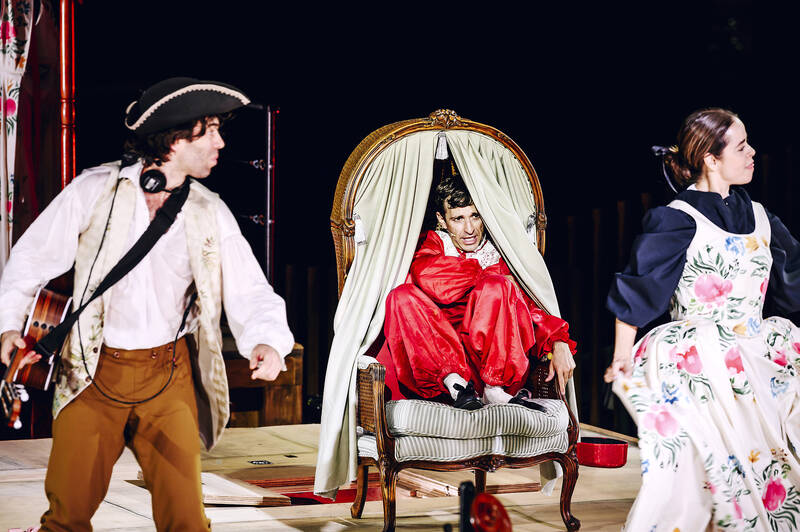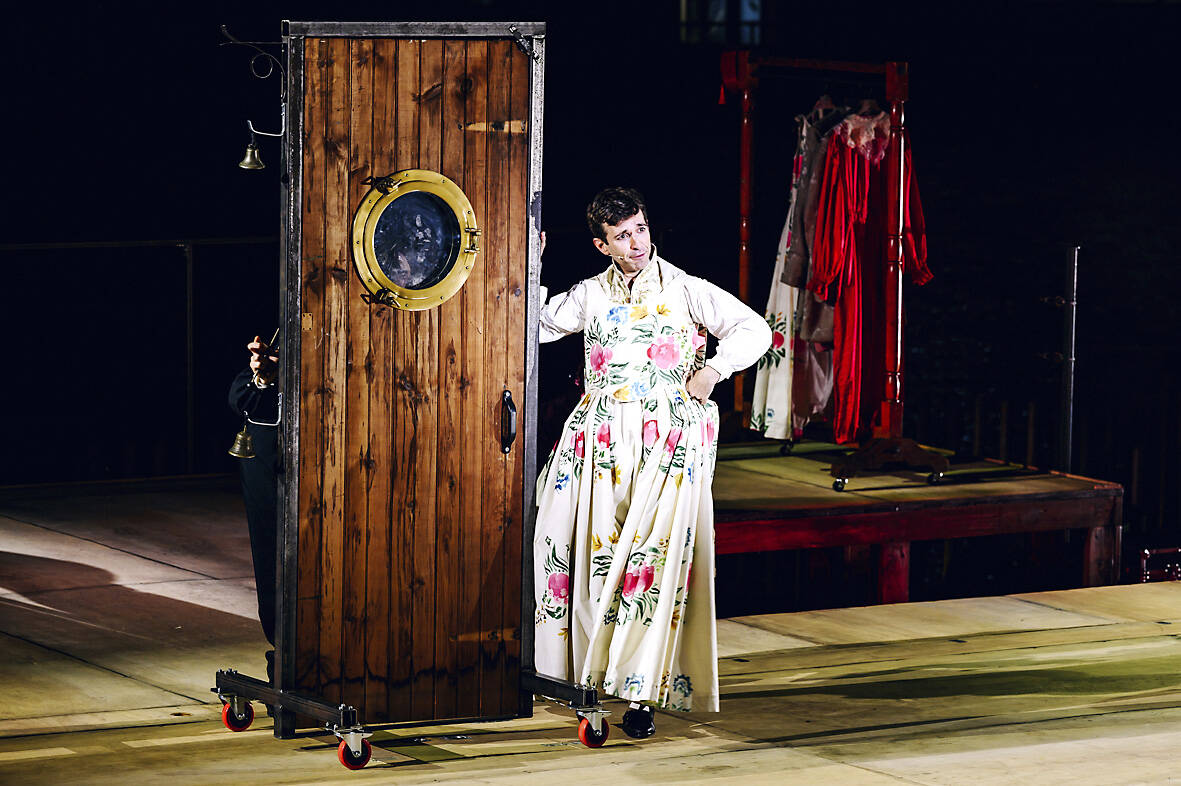Anthony Roth Costanzo gives a truly inside look at one of Mozart’s most loved operas.
Singing seven different roles in a madcap presentation of Le Nozze di Figaro (The Marriage of Figaro) at New York’s Little Island, the countertenor labors through the Countess’ Dove sono aria with a steel laryngoscope down his throat while a video recording of his throbbing vocal chords is displayed on screens.
“After the first part of the opera in which I’ve torn my voice to shreds essentially going through all of these hijinks and she has been carried offstage in a stretcher, she comes back in a hospital gown and she has this nightmare of her husband, the Count, giving her a laryngoscopy, which of course has all kinds of sexual innuendo,” Costanzo said.

Photo: AP
A 42-year-old Grammy Award winner who is among the world’s top countertenors, Costanzo sang Cherubino for his Opera Santa Barbara debut in 2000. He adds Figaro, Susanna, the Count, Countess, Antonio and Barbarina, stretching his voice 3 1/2 octaves in an invigorating and entertaining 95-minute reinvention of a work that premiered in 1786.
“When was the last time you went to an opera that wasn’t ‘Tristan’ thinking: Is he going to make it?” said Zack Winokur, Little Island’s producing artistic director.
TESTING THE PURISTS

Photo: AP
The 18-performance run, a highlight of Little Island’s first season, started last Friday at the 700-seat amphitheater built in Manhattan above the Hudson River and extends through Sept. 22.
“We just really want to tell the story of The Marriage of Figaro, show people who maybe don’t necessarily come to the opera a good time, kind of test the limits of what opera purists will tolerate,” director Dustin Wills said.
Costanzo’s concept developed after “Only an Octave Apart,” his concert performance with Justin Vivian Bond that reopened Brooklyn’s St. Ann’s Warehouse in 2021 following the pandemic closure and then went on tour. Staged by Winokur, the show mixed pop and classical, including Crudel! Perche finora, a third-act aria of the Count and Susanna, as a comic number.
“It stopped being a gag and started being just excellent, and I was like: ‘Can you do the rest of this?’” said Winokur, who staged the concert.
Winokur was hired to open Little Island’s first season in June. He had a slot available when a planned staging of Britten’s Peter Grimes fell through, and in January, participated in a Nozze workshop with Costanzo, Wills, dramaturg Jacob Mallinson Bird and music director Dan Schlosberg.
“It is such divine music and such mad-cap bananas storytelling,” Winokur said. “It’s very funny. It’s incredibly precise physically, and it is a kind of a Olympic task.”
Costanzo sang both Susanna and Figaro as a door kept swinging in the opening Cinque ... dieci ... venti. He took both parts of Sull’aria, performing the Countess live while a recording of his Susanna is played, seemingly from a Victrola.
“Singing harmony with myself was very bizarre,” he said. “What does it mean to sing with your own disembodied voice and what are all of the different, interpretations that we could have?”
Trims included Bartolo along with his La vendetta aria. Costanzo was backed by an eight-person orchestra that sounded light at times mixed with Costanzo’s amplified voice in the outdoor space.
MOZART APPROVED
He was joined by actors who mimed roles alongside him: Daniel Liu (Countess), Ariana Venturi (Count), Christopher Bannow (Figaro) and Emma Ramos (Susanna). They open dressed as a union work crew and wind up donning costumes to accomplish needed tasks, then are given microphones for the fourth-act finale. Each sang a few words, revealing Costanzo’s superiority in all tessitura.
Ryan Shinji Murray, who mouthed the small part of the gardener Antonio, did somersaults on a trampoline during the concluding ensemble after the Countess pardons the Count.
Costanzo felt he had a go-ahead from the composer, who died in 1791. He read a letter Mozart wrote to Abbe Bullinger proposing Pietro Metastasio write a libretto in which the leading man and woman never meet, allowing castrato Francesco Ceccarelli to portray both the lover and his mistress.
“If it’s Mozart approved,” Costanzo said, “we can’t feel we’re being too blasphemous.”

The Democratic Progressive Party (DPP), Chinese Nationalist Party (KMT), and the country’s other political groups dare not offend religious groups, says Chen Lih-ming (陳立民), founder of the Taiwan Anti-Religion Alliance (台灣反宗教者聯盟). “It’s the same in other democracies, of course, but because political struggles in Taiwan are extraordinarily fierce, you’ll see candidates visiting several temples each day ahead of elections. That adds impetus to religion here,” says the retired college lecturer. In Japan’s most recent election, the Liberal Democratic Party lost many votes because of its ties to the Unification Church (“the Moonies”). Chen contrasts the progress made by anti-religion movements in

Taiwan doesn’t have a lot of railways, but its network has plenty of history. The government-owned entity that last year became the Taiwan Railway Corp (TRC) has been operating trains since 1891. During the 1895-1945 period of Japanese rule, the colonial government made huge investments in rail infrastructure. The northern port city of Keelung was connected to Kaohsiung in the south. New lines appeared in Pingtung, Yilan and the Hualien-Taitung region. Railway enthusiasts exploring Taiwan will find plenty to amuse themselves. Taipei will soon gain its second rail-themed museum. Elsewhere there’s a number of endearing branch lines and rolling-stock collections, some

This was not supposed to be an election year. The local media is billing it as the “2025 great recall era” (2025大罷免時代) or the “2025 great recall wave” (2025大罷免潮), with many now just shortening it to “great recall.” As of this writing the number of campaigns that have submitted the requisite one percent of eligible voters signatures in legislative districts is 51 — 35 targeting Chinese Nationalist Party (KMT) caucus lawmakers and 16 targeting Democratic Progressive Party (DPP) lawmakers. The pan-green side has more as they started earlier. Many recall campaigns are billing themselves as “Winter Bluebirds” after the “Bluebird Action”

Last week the State Department made several small changes to its Web information on Taiwan. First, it removed a statement saying that the US “does not support Taiwan independence.” The current statement now reads: “We oppose any unilateral changes to the status quo from either side. We expect cross-strait differences to be resolved by peaceful means, free from coercion, in a manner acceptable to the people on both sides of the Strait.” In 2022 the administration of Joe Biden also removed that verbiage, but after a month of pressure from the People’s Republic of China (PRC), reinstated it. The American